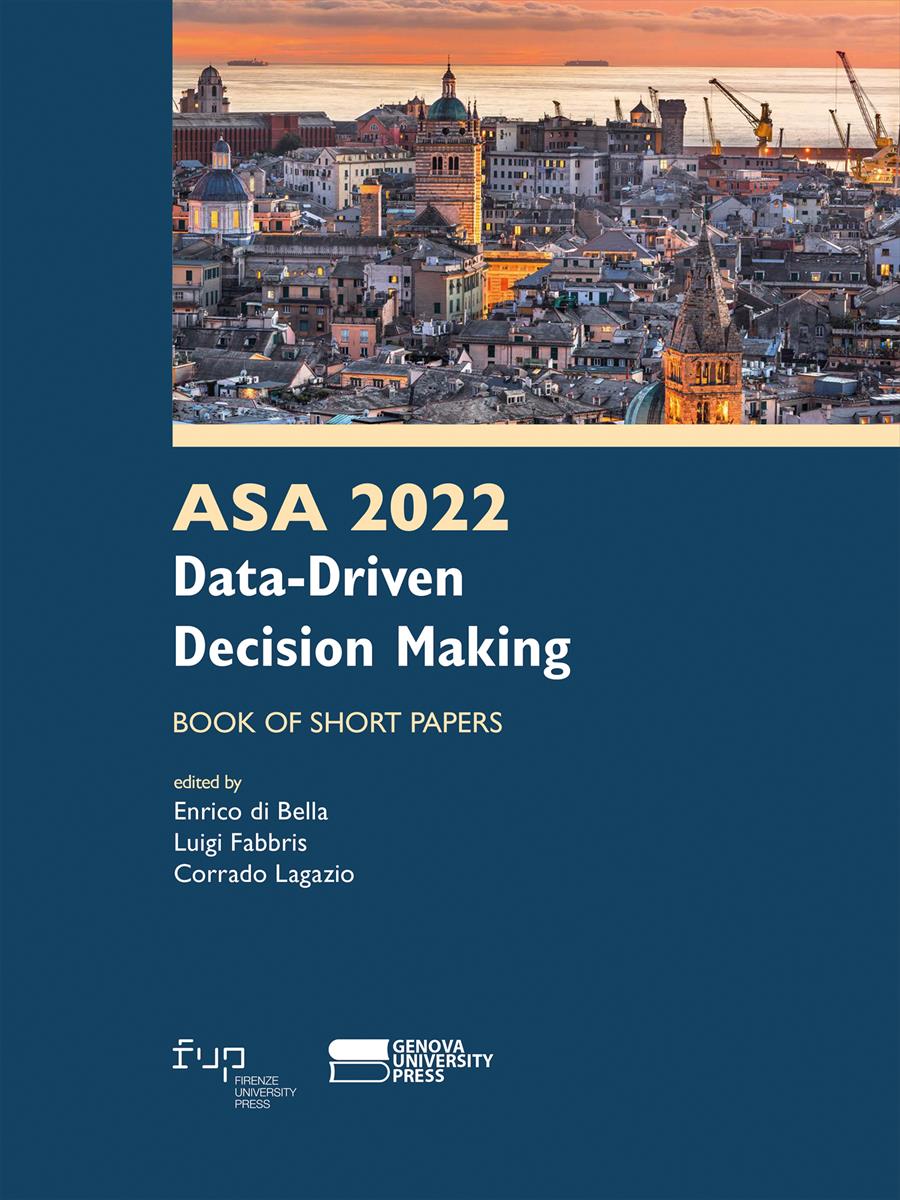- ASA 2022 Data-Driven Decision Making
- Edited by Enrico di Bella, Luigi Fabbris, Corrado Lagazio
Educational mismatch and productivity: evidence from LEED data on Italian firms
- Laura Bisio
- Matteo Lucchese
- © 2023 Author(s) |
- CC BY 4.0
- DOI: 10.36253/979-12-215-0106-3.52
This study aims at evaluating the impact of educational mismatch onto firm-level productivity for a large set of Italian firms. In particular, over (under)-education refers to situations where individual’s educational attainment is higher (lower) than the education required by the job, thereby producing a surplus (deficit) of education. Based on the integration of the LEED (Linked Employer Employee Database) Istat Statistical Register Asia Occupazione – which provides information on workers’ age, professional qualification and educational attainment – and the Istat Frame-SBS Register, we perform an analysis in the spirit of the ORU (Over, Required and Under Education) model proposed by Kampelmann e Rycx (2012). The dataset is based on a large panel of over 55,000 manufacturing and services firms with more than 20 employees, covering the 2014-2019 period. The empirical strategy is based on a two-step procedure: first, ORU indicators are computed at the worker-level; second, we estimate a firm-level productivity (value added per employee) function where the key variables of interest are the ORU indicators collapsed at the firm-level, taking into account both firm and workers characteristics. The productivity function is estimated by GMM-system by Arellano and Bond (1995) e Blundell and Bond (1988). Main results point out that over/under-education affects productivity growth in both manufacturing and services firms: firm’s productivity rises following a one unit increase in mean years of over-education – with spiking results for medium and high-tech manufacturing firms –, whereas a growth in under-education hampers productivity dynamics in high and medium-high tech manufacturing and knowledge-intensive services firms.
- Keywords:
- Educational mismatch,
- Productivity,
- Linked Employer-Employee Dataset,
- GMM-System,
ISTAT, Italian National Institute of Statistics, Italy - ORCID: 0000-0003-0922-6359
ISTAT, Italian National Institute of Statistics, Italy - ORCID: 0000-0001-8331-7393
- Arellano, M., and Bond, O. (1991). Some tests of specification for panel data: Monte Carlo evidence and an application to employment equations. Review of Economic Studies, 58(2), pp. 277–297.
- Arellano, M., and Bover, O. (1995). Another look at the instrumental variable estimation of error-components models. Journal of Econometrics, 68(1), pp. 29-51.
- Blundell, R., and Bond, S. (1998). Initial conditions and moment restrictions in dynamic panel data models. Journal of Econometrics, 87(1), pp. 115-143.
- Fanti, L., Guarascio, D., Tubiana, M. (2021). Skill mismatch and the dynamics of Italian companies’ productivity. Applied Economics, 53(59), pp. 6790-6803.
- Hansen, L. (1982). Large sample properties of generalized method of moments estimators. Econometrica, 50(4), pp. 1029–1054.
- Istat (2018). Rapporto sulla Competitività dei settori produttivi. Istat, Roma.
- Istat (2022). Rapporto sulla Competitività dei settori produttivi. Istat, Roma.
- Istat (2021). Rapporto Annuale sulla situazione del Paese. Istat, Roma.
- Kampelmann S., and Rycx F. (2012). The Impact of Educational Mismatch on Labour Productivity. Evidence from Linked Panel Data. Economics of Education Review, 31(6), pp. 918-931.
- Mahy, B., Rycx, F., Vermeylen, G. (2015). Educational Mismatch and Firm Productivity: Do Skills, Technology and Uncertainty Matter?. De Economist, 163, pp. 233-262.
- Monti, P., and Pellizzari M. (2016). Skill Mismatch and Labour Shortages in the Italian Labour Market. Innocenzo Gasparini Institute for Economic Research Policy Brief, 2.
- Montt, G. (2015). The causes and consequences of field-of-study mismatch: An analysis using PIAAC. OECD Social, Employment and Migration Working Papers, 167, OECD Publishing, Paris.
- OECD (2016). Skills Matter. Further Results from the Survey of Adult Skills. OECD Publishing, Paris.
- OECD (2022). Closing the Italian digital gap: The role of skills, intangibles and policies. OECD Science, Technology and Industry Policy Papers, 126, OECD Publishing, Paris.
Chapter Information
Chapter Title
Educational mismatch and productivity: evidence from LEED data on Italian firms
Authors
Laura Bisio, Matteo Lucchese
Language
English
DOI
10.36253/979-12-215-0106-3.52
Peer Reviewed
Publication Year
2023
Copyright Information
© 2023 Author(s)
Content License
Metadata License
Bibliographic Information
Book Title
ASA 2022 Data-Driven Decision Making
Book Subtitle
Book of short papers
Editors
Enrico di Bella, Luigi Fabbris, Corrado Lagazio
Peer Reviewed
Publication Year
2023
Copyright Information
© 2023 Author(s)
Content License
Metadata License
Publisher Name
Firenze University Press, Genova University Press
DOI
10.36253/979-12-215-0106-3
eISBN (pdf)
979-12-215-0106-3
eISBN (xml)
979-12-215-0107-0
Series Title
Proceedings e report
Series ISSN
2704-601X
Series E-ISSN
2704-5846
